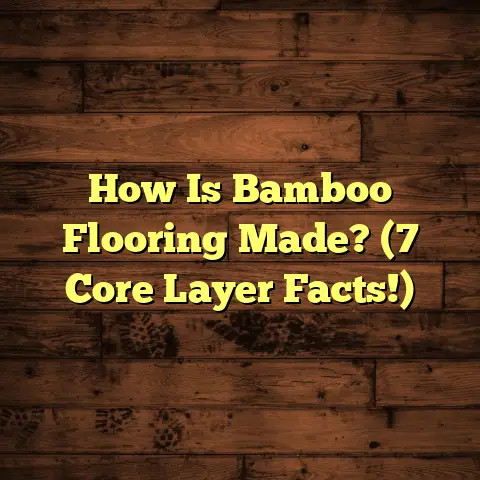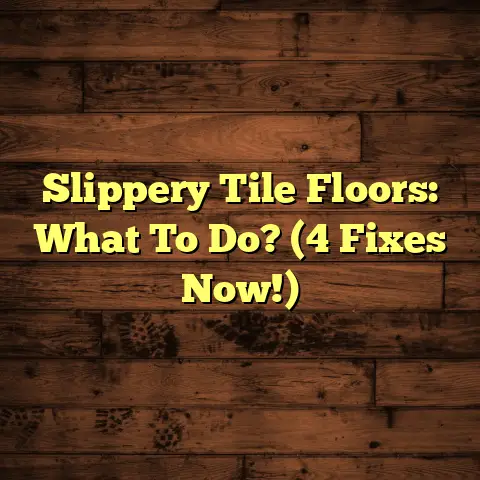Cheapest, Most Durable Flooring? (1 Mistake to Avoid!)
Having worked as a flooring contractor for many years, I’ve encountered every kind of flooring choice. One thing I’ve learned is that picking the right flooring isn’t just about looks. It’s also about saving money and energy in the long run.
Let’s dive into how your flooring choices can really impact your home’s energy efficiency, and ultimately, your wallet.
Flooring can play a bigger role in energy savings than you might think! Think about it: your floors cover a huge surface area in your home. That means they can significantly affect insulation, heating, and cooling.
The right flooring can help keep your home warmer in the winter and cooler in the summer, reducing your reliance on your HVAC system. This translates to lower utility bills and a more sustainable living environment. Who wouldn’t want that?
According to the U.S. Department of Energy, homes can lose up to 30% of their heating energy through floors over unheated spaces like garages or crawl spaces. That’s a huge chunk of energy (and money!) going to waste.
So, choosing the right flooring is not just about aesthetics; it’s a smart move for your wallet and the environment.
Section 1: Understanding Flooring Options
Alright, let’s break down the most common types of flooring materials out there. I’ll give you the lowdown on each, focusing on cost, durability, maintenance, and how they look.
-
Hardwood: Classic and beautiful, hardwood flooring adds a touch of elegance to any home.
It’s durable, but can be pricey.
Maintenance involves regular cleaning and occasional refinishing. -
Laminate: A budget-friendly alternative to hardwood.
Laminate is durable and easy to install.
It’s resistant to scratches and stains, making it great for busy households. -
Vinyl: Versatile and waterproof, vinyl flooring is perfect for bathrooms and kitchens.
It comes in sheets, tiles, and planks, and is relatively inexpensive.
Vinyl is also easy to clean and maintain. -
Tile: Durable and water-resistant, tile is a great choice for high-moisture areas.
It comes in various materials like ceramic, porcelain, and stone.
Tile can be cold underfoot, but it’s easy to clean and lasts a long time. -
Carpet: Soft and comfortable, carpet adds warmth and coziness to any room.
It’s available in various styles and colors, and is relatively affordable.
However, carpet requires regular vacuuming and can stain easily. -
Bamboo: An eco-friendly option, bamboo flooring is durable and stylish.
It’s similar in appearance to hardwood but is more sustainable.
Bamboo is also resistant to pests and moisture.
Each of these options has its own set of pros and cons. The best choice for you will depend on your budget, lifestyle, and aesthetic preferences.
Section 2: Cost Analysis of Flooring Materials
Let’s talk money! Understanding the costs associated with each flooring type is crucial for making a smart decision. We’ll look at initial costs, long-term expenses, and those sneaky hidden costs that can catch you off guard.
Initial Costs (Materials and Installation):
-
Hardwood: Expect to pay anywhere from $8 to $25+ per square foot installed.
-
Laminate: A more budget-friendly option at $3 to $12 per square foot installed.
-
Vinyl: Ranges from $2 to $10 per square foot installed, depending on the type.
-
Tile: Can vary widely, from $5 to $20+ per square foot installed.
-
Carpet: Typically costs $3 to $8 per square foot installed.
-
Bamboo: Similar to hardwood, ranging from $6 to $15 per square foot installed.
Long-Term Costs (Maintenance, Repair, and Replacement):
-
Hardwood: Requires refinishing every 7-10 years, costing $3 to $8 per square foot.
-
Laminate: May need replacement after 10-20 years, depending on quality.
-
Vinyl: Can last 10-20 years with proper care, but is difficult to repair.
-
Tile: Very durable, but grout may need occasional cleaning and sealing.
-
Carpet: Requires regular cleaning and may need replacement every 5-10 years.
-
Bamboo: Similar to hardwood in terms of maintenance and lifespan.
Here’s a quick comparison table to give you a clearer picture:
| Flooring Type | Avg. Price Per Sq. Ft. (Installed) |
|---|---|
| Hardwood | $8 – $25+ |
| Laminate | $3 – $12 |
| Vinyl | $2 – $10 |
| Tile | $5 – $20+ |
| Carpet | $3 – $8 |
| Bamboo | $6 – $15 |
Hidden Costs:
Don’t forget about those hidden costs that can add up quickly!
-
Underlayment: Essential for laminate and vinyl flooring, adding $0.50 to $2 per square foot.
-
Preparation Work: Subfloor repairs, leveling, and moisture testing can add significant costs.
-
Removal of Old Flooring: Removing old flooring can cost $1 to $5 per square foot.
-
Trim and Molding: Baseboards, quarter rounds, and other trim can add to the overall cost.
Always get a detailed quote from your contractor to avoid any surprises down the road.
Section 3: Durability and Longevity
Let’s define what we mean by “durability” when it comes to flooring. In my book, durability is all about how well a flooring material can withstand wear and tear, moisture, and other types of damage over time.
Lifespan of Each Flooring Type:
-
Hardwood: Can last for decades with proper care. Refinishing can extend its lifespan significantly.
-
Laminate: Typically lasts 10-20 years, depending on the quality and traffic.
-
Vinyl: Can last 10-20 years, but is susceptible to punctures and tears.
-
Tile: Extremely durable and can last for generations with proper maintenance.
-
Carpet: Typically needs replacement every 5-10 years, depending on traffic and maintenance.
-
Bamboo: Can last 20-50 years with proper care, similar to hardwood.
Factors Affecting Durability:
-
Wear and Tear: High-traffic areas will wear down flooring faster.
-
Moisture Resistance: Flooring in bathrooms and kitchens needs to be water-resistant.
-
Susceptibility to Damage: Some flooring types are more prone to scratches, dents, and stains.
Case Studies:
I remember one client who installed cheap laminate flooring in their kitchen to save money. Within a year, the flooring was peeling and bubbling due to moisture. They ended up having to replace it with vinyl, costing them even more in the long run.
On the other hand, I’ve seen tile floors that have lasted for over 50 years with minimal maintenance. Investing in durable flooring upfront can save you a lot of headaches and money down the road.
Section 4: The Cheapest vs. Most Durable Dilemma
It’s tempting to go for the cheapest flooring option to save money upfront. But is it really the best choice? Let’s explore the trade-offs between cost and durability.
The Misconception:
Many homeowners believe that the cheapest flooring is the best option, especially if they’re on a tight budget. However, this can be a costly mistake.
Trade-offs:
Cheaper materials may require more frequent replacement or repair. This can lead to higher long-term expenses and a lot of frustration.
For example, that bargain-basement carpet might look great at first, but it could start showing wear and tear within a year or two. Suddenly, you’re facing the cost and hassle of replacing it much sooner than expected.
Value Over Price:
Instead of focusing solely on price, consider the value you’re getting for your money. Investing in slightly more expensive but durable flooring may save you money in the long run.
Think of it like this: would you rather buy a cheap car that breaks down every few months, or a more reliable car that lasts for years with minimal maintenance? The same principle applies to flooring.
Section 5: 1 Mistake to Avoid
Okay, let’s get to the heart of the matter. The biggest mistake I see homeowners make is prioritizing upfront cost over durability.
Why This Is a Mistake:
This mistake can lead to a whole host of problems:
-
Frustration: Constantly dealing with damaged or worn-out flooring is incredibly frustrating.
-
Increased Costs: Frequent repairs and replacements can quickly add up.
-
Wasted Time: Dealing with flooring issues takes time and energy that could be spent elsewhere.
Examples:
I had a client who chose cheap laminate flooring for their entire house to save money. Within a few years, the flooring was scratched, dented, and faded. They ended up having to replace it all, costing them twice as much as if they had invested in durable flooring from the start.
Another client chose cheap carpet for their rental property. The carpet was stained and worn out within a year, making it difficult to attract tenants. They ended up having to replace the carpet every year, costing them a fortune in the long run.
The Consequences:
These are just a few examples of how prioritizing upfront cost over durability can backfire. In the long run, it’s almost always cheaper to invest in durable flooring that will last for years.
Section 6: Making an Informed Decision
So, how do you make sure you’re making the right choice? Here’s some guidance on how to assess your individual needs and select flooring that’s right for you.
Assess Your Needs:
-
Household Activity Level: Do you have kids or pets? Choose flooring that can withstand heavy traffic and spills.
-
Climate Considerations: If you live in a humid climate, choose water-resistant flooring like vinyl or tile.
-
Personal Aesthetic Preferences: Choose flooring that complements your home’s style and your personal taste.
Consider Your Long-Term Goals:
Think about how long you plan to stay in your home. If you’re planning to sell in a few years, choose flooring that will appeal to potential buyers. If you’re planning to stay for the long haul, invest in durable flooring that will last for years.
Ask Questions:
Don’t be afraid to ask your contractor questions! A good contractor will be able to help you choose the right flooring for your needs and budget.
Section 7: Energy-Efficient Flooring Choices
Now, let’s talk about energy efficiency. Some flooring materials are better at insulating your home than others. Here are a few options that offer both affordability and durability while contributing to energy savings:
-
Cork Flooring: Cork is a natural insulator that can help keep your home warm in the winter and cool in the summer. It’s also durable and eco-friendly.
-
Bamboo Flooring: Bamboo is a sustainable material that offers good insulation properties. It’s also durable and stylish.
-
Carpet: Carpet provides excellent insulation and can help reduce energy costs. Choose a low-pile carpet for better energy efficiency.
Thermal Insulation:
These flooring options excel in thermal insulation and can help maintain comfortable indoor temperatures. This can reduce your reliance on your HVAC system and lower your energy bills.
Certifications and Ratings:
Look for certifications like Energy Star when choosing flooring. These certifications indicate that the flooring meets certain energy-efficiency standards.
Conclusion
Alright, we’ve covered a lot of ground! Let’s recap the key points:
-
Choosing the right flooring is about more than just aesthetics.
-
Prioritizing upfront cost over durability is a common mistake that can lead to frustration and increased costs.
-
Investing in durable flooring can save you money in the long run.
-
Consider your individual needs and long-term goals when selecting flooring.
-
Choose energy-efficient flooring options to reduce your energy bills and create a more sustainable living environment.
Remember, making informed decisions is key when it comes to flooring selection. Balance the initial cost with the long-term value, and you’ll be sure to choose flooring that you’ll love for years to come.
Your flooring choice can have a significant impact on your energy savings and overall home comfort. So, take your time, do your research, and choose wisely!





